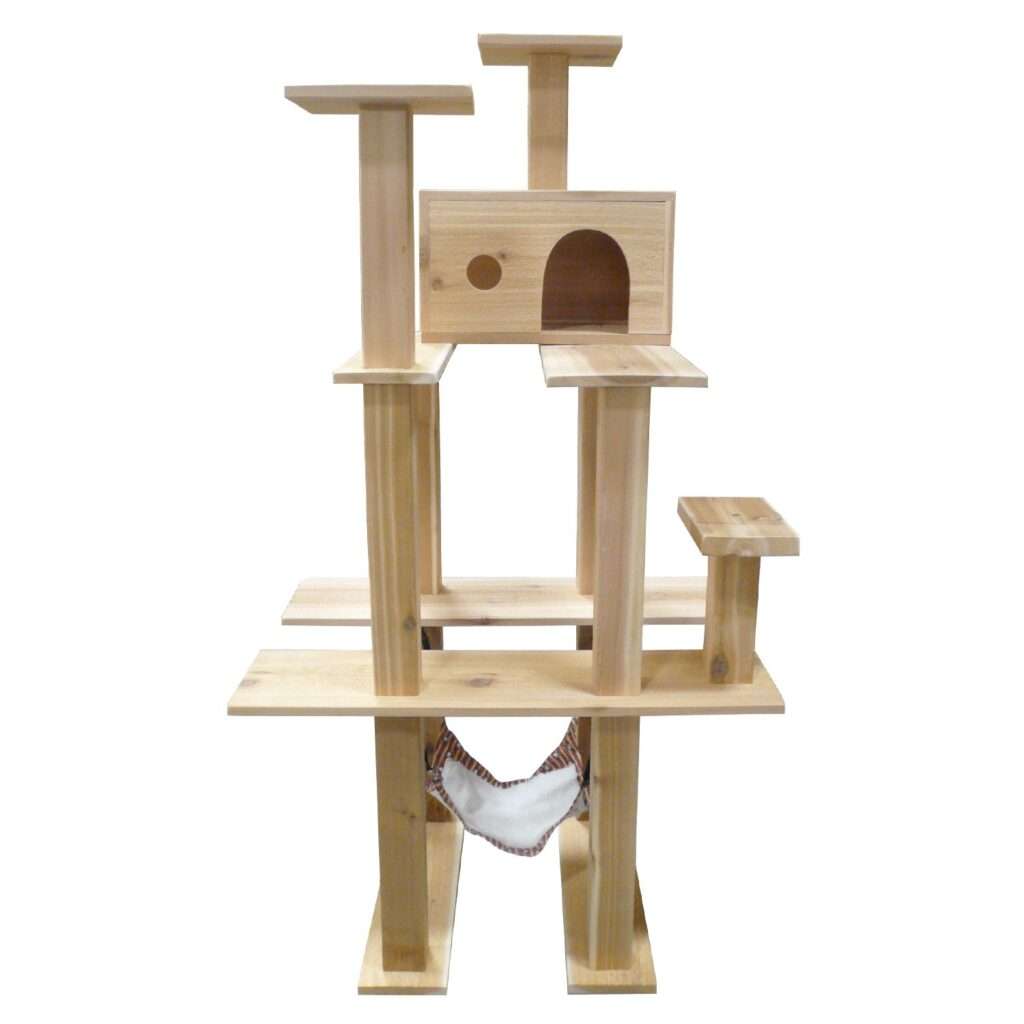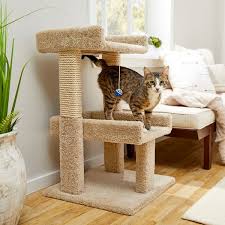Cats are playful, inquisitive, and sometimes mischievous. As caring pet owners, it is natural to want to offer them a secure and engaging environment. A great way to improve your cat’s environment is by providing them with a cat tree at home. But what exactly is a cat tree? Why do cats love them? And how can selecting t he right one benefit your feline companion?
Learn more about: Hairless cats
In this detailed guide, we’ll cover everything you need to know about cat trees, from their advantages, the different types available, and tips for choosing the best one for your cat.

What Is a Cat Tree?
A cat tree is a multi-level structure designed specifically for cats to climb, scratch, perch, and rest. These structures often feature platforms, hiding spots, scratch posts, and sometimes interactive toys. Cat trees give your feline a chance to climb and play by adding vertical territory indoors.
These structures are modeled after natural elements such as trees, branches, and sheltered spots, which help encourage physical activity and satisfy their natural behaviors like climbing, scratching, and observing from a high place.
Why Do Cats Need a Cat Tree?
Encourages Exercise and Physical Activity
Indoor cats may not get the same opportunity to run and climb as outdoor cats. A cat tree helps them stay active by offering spaces for jumping, climbing, and stretching, which supports their overall health and fitness.
Supports Natural Instincts
Cats are instinctive climbers and scratchers. Cat trees give them a safe area to express these behaviors, which can prevent them from damaging furniture or carpets.
Provides Mental Stimulation and Enrichment
Exploring new heights, discovering cozy hiding places, and playing with attached toys can keep a cat mentally engaged, helping to avoid boredom and reducing issues like excessive meowing or aggressive behavior.
Offers a Safe Personal Space
Cats appreciate having their territory. A cat tree gives them a private spot where they can relax, watch their surroundings, and feel secure.
Reduces Stress in Multi-Cat Households
Vertical space is especially valuable in homes with multiple cats.
Cat trees create separate areas, which can help reduce tension between cats by allowing them to have personal space when needed.
Types of Cat Trees: Which One Is Right for Your Cat?
Cat trees are available in a wide range of designs, dimensions, and materials. The choice depends on your cat’s personality, age, and your available space.
Basic Cat Trees
These usually have one or two levels, a scratching post, and a small platform for resting. They are suitable for kittens or cats that prefer simpler structures.
Multi-Level Cat Trees
For more active cats, multi-level trees with several platforms and hidden spots provide ample space for crawling, climbing, and exploring.
Cat Condos and Towers
These have enclosed cubbies where cats can hide and rest. They are ideal for shy or older cats who like to feel secure and cozy.
Wall-Mounted Cat Trees
These modern designs save floor space by attaching climbing shelves or steps to walls. They work well in smaller homes or apartments.
DIY Cat Trees
For those who enjoy crafting, building a custom cat tree that suits your cat’s preferences can be a fulfilling project.
Key Features to Consider Before Buying a Cat Tree
Stability
Cats enjoy jumping and climbing, so a wobbly tree can be dangerous. Choose a tree with a sturdy base and quality construction.
Size and Height
Consider your cat’s size and the space available. Taller trees are great for active climbers but may not fit all homes.
Material
Natural wood or sisal rope is durable and preferred by cats. Avoid materials that could be harmful or toxic.
Easy to Clean
Choose cat trees that have removable covers or washable cushions to make cleaning easier and maintain hygiene.
Features
Some trees come with additional features like hanging toys, ramps, or even built-in feeding stations.
Tips for Helping Your Cat Adjust to a New Cat Tree
- Place the tree near a window or a spot where your cat usually rests to encourage exploration.
- Use treats or catnip to attract your cat to the tree.
- Avoid forcing your cat to use the tree; let them explore on their own time.
- Praise and reward your cat when they use the tree to reinforce positive behavior.
Benefits of Cat Trees for Specific Cat Types
For Kittens
- Play and physical activity are especially important for kittens.
- A cat tree encourages movement, helping them build coordination and self-assurance.
For Senior Cats
Older cats enjoy resting in elevated, cozy spots where they can feel secure while still being able to observe their surroundings.
For Multi-Cat Families
Vertical space can reduce tension and territorial disputes, allowing each cat to claim and enjoy their area.
FAQs
While many cats enjoy cat trees, some may be hesitant or not interested. Personality and past experiences play a role. A gradual introduction and positive reinforcement can help.
Yes. Providing dedicated scratching posts can help reduce unwanted scratching on furniture.
Clean the cushions or mats regularly. Replace the tree if it becomes unstable or worn to ensure your cat’s safety.
DIY Cat Tree Ideas: Personalize Your Cat’s Playground
If you enjoy DIY projects, consider building a custom cat tree using safe materials like untreated wood and sisal rope. Designing a custom cat tree lets you tailor it to fit your cat’s likes while complementing your home’s style.
Signs Your Cat Needs a Cat Tree
- Excessive scratching on furniture
- Restlessness or boredom
- Lack of exercise or weight gain
- Hiding or seeking high places
- Signs of stress or aggression
Providing a cat tree can address many of these issues by offering a safe and stimulating environment.
Conclusion
A cat tree is more than just furniture; it is a valuable tool for enriching your cat’s life. It promotes both their physical health and mental stimulation while encouraging instincts. Whether you choose a simple scratching post or a large multi-level tower, investing in a good cat tree is a gift your cat will truly appreciate for years to come.
If you have not introduced a cat tree yet, consider doing so today. Your cat will thank you with happy purrs, playful behavior, and a healthier lifestyle.


Pingback: Bernedoodle Dog Breed: Traits, Care & Sizes -